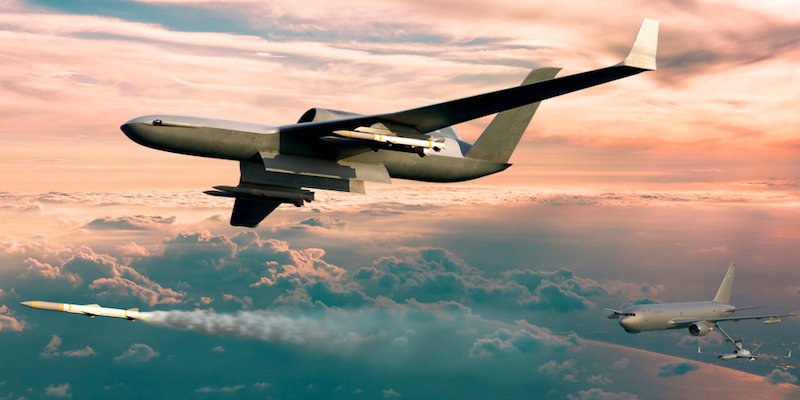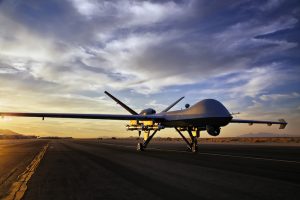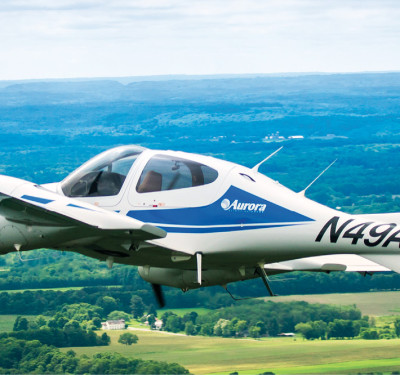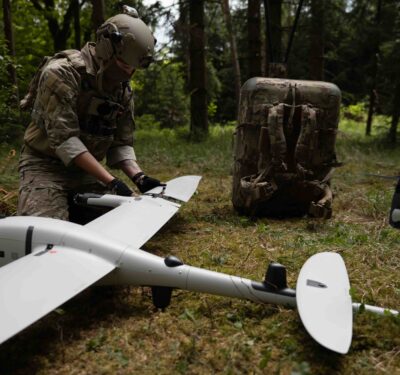
The Defender is one of GA-ASI’s future unmanned systems concepts. The system will deliver information and decision superiority from sensing to strike.
In June, the Air Force sent out a request for information (RFI) on a “Next Generation ISR/Strike Platform” to replace the venerable General Atomics MQ-9 Reaper.[1] To be honest, I think the MQ-9 still has decades of service in it and rumors of an MQ-9 replacement coming from the Air Staff are as frequent as Elvis sightings in Vegas. Adding to my doubts is the fact that the Air Force produced this RFI suspiciously soon after Congress grilled Dr. William Roper, chief acquisition officer for the Secretary of the Air Force (SAF/AQ), about cutting the MQ-9 in the Air Force without having a replacement plan.
All doubts aside, the thought of a clean-slate start to a new unmanned ISR/Strike system got me thinking—if my generation of unmanned-experienced airmen had the chance to construct an unmanned combat system again, what would we do different? After a bunch of phone calls to acquisition vets, former drone crew and old hands on the Air Staff, we formed the collective advice that follows.

“Always there—always ready.” The MQ-9A Reaper’s persistence and 90% mission capable rate empowers the Joint Force to Connect, Know and Act when they need it most.
System is Spot On
The RFI is well worth a read and if you are in the military drone business I guarantee your competition has read it. The RFI stresses that the Air Force wants a new unmanned system and not just a new drone. My generation of unmanned airmen wasted a lot of time treating the MQ-9, and its predecessor MQ-1, as stand-alone aerial weapons for which a single crew flew a single drone for a single sortie—just like the Air Force flies manned aircraft. It took the titanic pressure of 9/11 to make the Air Force realize it could station air crews remotely rather than making them fly MQ-9’s from their launch field. It also took a long time before the Air Force realized that stationing most of its remote aircrew in a single location would bring efficiencies. Getting the MQ-1/9 community to accept remoted intelligence analysts as part of its team was another hard sell. And Air Force intelligence echoed the crawl with respect to fully integrating MQ-1/9’s into its world-wide Distributed Common Ground System.
Along the haul, the Air Force did learn lessons, and that has produced a number of changes that will make it much easier to build a new unmanned system instead of just delivering an improved MQ-9. The Air Force now has common standards for unmanned control systems and sensors, improved crew manning procedures and an integrated management system that allows it to operate this tremendously complex system as a single entity. All AFMC (Air Force Materiel Command) must do is follow through and require contractors to deliver new products without proprietary interfaces that work seamlessly with the existing unmanned systems.
It’s the Data Link, Stupid . . . Or Is It?
The RFI only mentions data links once and I initially saw that as a weakness. Indeed, every operational debate I had about the MQ-9 eventually devolved to discussion on link limitations. Africa Command needs an MQ-9? Ouch. That will be expensive because few commercial satellites cover Africa. Central Command wants to triple coverage over Iraq? Yikes. That will be tough because CNN outbid us for satellite transponders. Special Operations Command wants to use the line of sight link in Afghanistan but is mad because terrain interferes with the link. Sigh. Seems we need to review physics with some folks, again.
However, a closer review of the RFI shows the Air Force understands links are the weak link and is asking for a system with autonomy to both fly the air vehicle and process the data it collects. Autonomy lessens reliance on high-bandwidth datalinks because the air vehicle can fly itself to the correct target, rather than having a remote aircrew give it constant stick-and-rudder commands. More importantly, autonomous ISR sensors can find targets themselves and only send snippets of imagery back for human confirmation, if they send anything back at all.
If my generation had it to do over again, we would have insisted on greater system autonomy. True, ISR sensor autonomy wasn’t available in the early 2000’s but flight control system autonomy was fairly advanced. I wish we had asked for it back then and hope industry responds to the RFI with some great ideas on autonomy.
Attritable Vs Reliable
The RFI talks about wanting attritable drones quite a bit, but my generation had a love-hate relationship with them. The Air Force originally categorized the MQ-1/9 as attritable aircraft, meaning crews did not have to go through months-long safety investigations when they crashed a drone. As a result, accident rates for the MQ-1/9 soared to five times that of manned fighters. That trend didn’t go over too well. In a bid to reduce unmanned accidents the Air Force changed the MQ-1/9 to “line” aircraft, meaning crews and commanders had to brief loss of an airframe all the way up the chain to their four star general. Accident rates for the MQ-1/9 dropped below manned fighters within two years.
The notion that drones were attritable also led the Air Force to cut corners in systems design. Manned aircraft always have double—and sometimes triple or quadruple— redundancy in flight-critical systems like flight controls. Early models of the MQ-1 had several such systems without backups, and it took a lot of hard work to fix these flaws after multiple peacetime accidents.
I hope the MQ-X insists on attritable but extremely reliable drones. It is more expensive to include backups for all flight-critical systems, but the Air Force won’t just fly the MQ-X in combat and it is always hard to explain to a surviving relative that a backup system would have prevented a crash on her house.
Human Factors are Vital Even in the Humanless Air Force
If the early MQ-1/9 ground control stations (GCS) had any sort of human factors engineering in them, it eluded me. Air Force F-15 and F-16 pilots were used to exquisitely designed “hands-on throttle and stick” controls, precisely laid out instruments and even helmets that allowed them to target something just by turning their head. Imagine their surprise when confronted with a GCS that could have been placed anywhere on the planet and in any type of building but was inexplicably built in a cramped aluminum box someone decided to park in the Nevada desert, not Hawaii or Florida. Controls that could have come from the very latest fighter design were instead just a stick for control and a slider-like thingy for the throttle. Control menus were worse. The Air Force lost two MQ-1’s because the engine on/off switch was buried under multiple nesting choices and it took remote crews too long to get to it.
Although the RFI doesn’t mention human factors, I hope a lot of attention is paid to them. The good news is that General Atomics spent a lot of its own capital designing a Block 50 GCS for the MQ-9 with a tremendous amount of human engineering packed into it. Ambient lighting, fully adjustable seats that even Porsche would envy and a combined synthetic/sensor vision system all coalesce to help keep crews focused and on target. I hope AFMC remembers that, for once, it can acquire an aircraft cockpit that isn’t constrained by size, weight or power. Since it is a ground control station, the MQ-X GCS could take up a whole room, weigh several tons and consume more power than a New York subway train if it’s needed. I recommend AFMC find the best human factors engineers to build a GCS even better than the Block 50 MQ-9 GCS. Use all the size, weight and power you need.
Unman the Unmanned Air Force
My unmanned generation nearly unmanned the Air Force manning our unmanned workforce because it took us too long to realize we could do it without increasing risk or decreasing effectiveness. As noted above, wewere trapped in a crew concept centered on the air vehicle and not the mission. The first mistake was designing a two-person GCS for the MQ-1/9. Of course, F-16s, F-15Es, F-18s, A-10s and F-35s all rely on a single aircrew to fly the aircraft and control its sensors. In hindsight, we should have done the same with the MQ-1/9 but never invested in the human factors research needed (see above) to make a safe single-crew GCS. Although we figured out how to realize some manpower efficiencies by consolidating remote aircrew in just a few places, we didn’t use these large manpower pools to make missions more efficient. An MQ-9 droning for hours over the ocean to reach a target had the same two aircrew flying as an MQ-9 engaged in close air support for troops in contact. An MQ-9 boring holes in the sky for days surveilling a single house for activity still had a pilot, a sensor operator and up to seven intelligence analysts all staring at the same house. Multiply each of these crew positions by seven to allow for shift work, training, illness, dental appointments and leave and you quickly have thousands of airmen required to man the 65 unmanned aircraft combat air patrols required by the Joint Staff.
The Air Force has gotten better over the years. The 480th ISR Wing that is charged with supplying intelligence analysis to the Air Force unmanned fleet adopted a target-centric rather than tail-centric staffing process. Today, surveilling a single house for days gets two analysts instead of seven; the other five work higher-priority targets unless the Special Operations bubbas decide to down the house. General Atomics has a single-crew GCS that halves crew requirements, a remote taxi ability that removes the need for launch/recovery crews stationed overseas, and a multi-mission control capability that lets a single pilot control six MQ-9’s droning over oceans or boring holes in the sky over high-interest houses. Good progress.
The Air Force hasn’t adopted all these manpower-saving measures yet, but I hope AFMC takes manpower efficiencies to heart as it acquires this new system. The RFI is full of references to autonomy and that will go a long way to help to unman the unmanned Air Force. However, other concepts like target-centric analysis and variable remote crew staffing must come from operations and intelligence leadership; the Air Force cannot just buy it.
Boring Bits Matter
Air Force recruiting commercials always have at least one cool satellite zooming past to flash commands to a drone. The truth is, all those cool satellites orbiting the earth have extensive ground communications segments that use plain old fiber optic cables and routers just like your cell phone does. Ever wonder how the cell phone companies keep your phone connected just about anywhere? They use redundant ground communication circuits, multiple power sources at key nodes and even alternate fiber cable routes to ensure a single storm does not stop you from binge watching “The Bachelor” on your phone. The Air Force did not have a system like your cell phone company in the early unmanned days; it had a bunch of single thread connections that could cut off drone control if they failed. I can still remember the “fun” of explaining to the Chief of Staff of the U.S. Air Force how an airman took out communication to every drone over Afghanistan because he pulled the wrong power switch. What is worse, the early ground network induced about five seconds of delay between control inputs made stateside to drones flying over Southwest Asia. Sensor image quality lost several resolutions of clarity going from the air vehicle to intelligence analysts because it was encrypted/decrypted several times as it passed between networks.
Fortunately, the Air Force has fixed most of these flaws. But if I were running the MQ-X acquisition I wouldn’t trust the ground segment to stay fixed unless I made reliability, system latency and image quality consistency a major part of the program. Data transport is the center of gravity for future UAS and merits deliberate development as an essential component of the system. Granted, it won’t be the coolest thing they’ve ever acquired, but it might be the most important.
In the End, Will It Be Cheaper and Better?
I am confident that the Air Force isn’t just trying to distract Congress and that they really do want a system to replace the MQ-9. I am less confident that analysis of the present system versus any new offerings will yield a cheaper, more effective system except in one key area. The present MQ-9 fleet has years, if not decades, of flight time left in it. There is a new, ergonomic GCS available and new crew tech/concepts that radically cut manpower. It took a while, but the Air Force really has built a single unmanned warfare system out of disparate parts, fixed issues with MQ-9 reliability and even made the ground segment much more resilient.
The only issue in the present system that gives me serious concern is its continued reliance on vulnerable high capacity data links. Could the Air Force just add more autonomy to the MQ-9 and sensors to reduce reliance on high capacity data links? Maybe. Should the Air Force ask everyone in industry—particularly the commercial drone industry—if they have a better idea to break reliance on links? Definitely. And that is why I can’t wait to see what they come up with.
Photos courtesy of General Atomics






